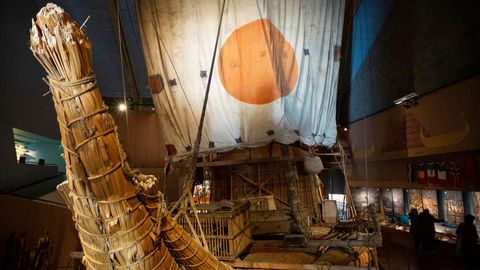
Norway’s tumultuous relationship with the sea has written some of the most defining chapters in its history. Travel+Leisure India & South Asia’s contributor learnt these on a tour of Oslo’s museums. Here’s a guide for when you make the voyage.
When I visited Norway last summer, I didn’t know how important the sea was to this small nation so close to the top of the world. When you account for the myriad fjords and islands for which Norway is famous, its coastline is over 58,000 kilometres—second only to Canada, which has an immense coastline of 2,02,000 kilometres. But when you compare their ratio of land area to coastline, Norway stands at 6.6 and the much bigger Canada at 49.4. In other words, no place in Norway is very far from the sea. This leads to a robust maritime culture and tradition, and explains the Norwegians’ passionate love for the sea.
The Viking Planet

The glorious history of Norwegian maritime exploration starts with the Viking Age, which stretched from 793 AD to 1066 AD, when intrepid Norse seafarers set sail to conquer— and settle along the coasts of— Great Britain, France, Italy, Russia, Iceland, and Greenland. The word ‘Viking’ comes from a verb that means to go raiding overseas, and this is what first comes to mind when one thinks of Norwegian history. But the descendants of the Norse seafarers today are conflicted about their ancestors. Were the Vikings fearless explorers or ruthless marauders? You can decide for yourself by visiting the high-tech entertainment centre in Oslo called The Viking Planet. It offers several excellent Virtual Reality (VR) shows with illustrations, animation, and text, as well as a hologram theatre, which transports you to the Viking Age. I particularly enjoyed a show in which the viewer is trapped on board a Viking longship that is under siege.
The Fram Museum

The next day, I crossed the sparkling blue water of the Oslofjord on a ferry to reach the nearby Bygdøy peninsula, which is home to Norway’s crown jewels of maritime history. The first of these is the Fram Museum, which houses the greatest wooden ship from the age of early Norwegian polar exploration. The beautifully restored Fram occupies the entire hangar, and as I gazed at it towering above me, I marvelled at the incredible adventures it had seen. The last and greatest of these was when it carried Roald Amundsen and his crew down to Antarctica for their memorable tryst with the South Pole on December 14, 1911.

The reclusive, but singularly resolute and resourceful, Amundsen stands the tallest among a pantheon of great Norwegian polar explorers. Apart from being the first to reach the South Pole, he was also the first to navigate the fabled Northwest Passage—on the ship Gjøa, which is also housed in the museum in an adjacent hangar. You can board both ships and explore their decks and cramped quarters. The museum is packed with exhibits, maps, pictures, and other artefacts of various Norwegian polar expeditions.
The Kon-Tiki Museum

When I was a young boy growing up in India, the fantastic ocean voyages of the famous Norwegian adventurer and ethnologist Thor Heyerdahl had already captured the imagination of the world. So the Kon-Tiki Museum on Bygdøy was high on my list. As a young explorer who spent his honeymoon in Polynesia, Heyerdahl was fascinated by the idea that the statues on Easter Island were the work of humans who had come from South America rather than Southeast Asia, as was the received wisdom at the time.

He set out to prove his idea by building a balsawood raft, which he then sailed with a crew of six men and a parrot from Callao, Peru, across 6,900 kilometres of open ocean, before running aground on the uninhabited Raroia atoll.

This fantastic voyage aboard the Kon-Tiki (named after an Inca god of the sun), braving raging storms and surviving on fi sh, took 101 days. To a world emerging from the devastation of World War II and eager for peacetime heroes, Thor Heyerdahl’s crossing of the Atlantic in this flimsy craft was a thrilling adventure— the ‘moon landing of its time’. Later on, a documentary was made on the Kon-Tiki expedition using black-and-white footage shot on the journey and won an Oscar in 1951. I viewed this at the museum, and walked around the actual Kon-Tiki raft itself as well as a boat built of papyrus reed called Ra II, in which Heyerdahl sailed from Morocco to Barbados in 1970. His theories about intrepid seafarers who worshipped the sun and crossed the oceans in prehistoric times, thus linking great civilisations, have remained the subject of controversy. But there is no doubt in my mind that Thor Heyerdahl will be remembered forever, not only as a great adventurer and explorer but also as a humanitarian who was committed to protecting the environment, particularly the oceans, and working for world peace.
Norway’s Resistance Museum

Unfortunately, the sea has brought its share of tragedy to Norway as well. On April 9, 1940, the Nazis invaded Norway in a surprise attack, and their troops overran the hapless country in a matter of weeks. Strategically, there were three reasons for this: the occupation of Norway allowed the German forces to secure ice-free harbours to control the North Atlantic; to secure the routes used to transport iron ore from Sweden; and to pre-empt an Allied invasion with the same purpose. Sweden escaped a similar fate because it was a neutral country (although, in reality, some members of its then ruling elite had Nazi leanings), because it was a reliable and vital source of iron ore for the German war machine, and because it did not have the same strategic geopolitical value as Norway.
I spent a reflective couple of hours at Norway’s Resistance Museum, which is housed in a sombre brown building with a slate roof in the heart of the Akershus Fortress in Oslo. The museum collection focusses on the Nazi occupation of Norway from 1940 to 1945 and the active opposition of the Norwegian underground resistance. It has interesting displays in the form of newspapers, recordings, pictures, models, objects, and documents. The operations of the resistance movement ranged from writing and distributing underground newspapers to smuggling people and goods to and from Sweden and the United Kingdom, and even sinking ships, destroying train tracks, and blowing up factories to disrupt German trade and supply routes.
The Norwegian America Line

In the first half of the 1800s, as Norway’s population began to grow more rapidly, the economy came under extreme stress as the largely agrarian society and rigid landownership norms were unable to create enough employment opportunities. The inevitable social unrest led to waves of mass emigration to the New World. Between 1825 and 1925, 800,000 Norwegians went to the United States, mostly settling in the Midwest. During this period, Norway is estimated to have lost a larger share of its population to the United States than any other country, with the exception of Ireland.
Given the enormous business opportunity of transporting these vast numbers, conditions were perfect for the launch of The Norwegian America Line in 1910. Right from the beginning, the three grand passenger liners of the Norwegian America Line (NAL) were a cut above their British competitors and were celebrated in Norwegian society. Such a grand enterprise had to have an equally grand presence on the land, and this was the case with its NeoBaroque headquarters on the corner of Jernbanetorget Square.
For the next seven decades, Norwegian America Line was the most important maritime representative of a mostly maritime nation before relentless competition from air travel forced it to sell its last cruise liners in 1980. But its name lives on, as the headquarters building was completely remodelled to open as the boutique hotel Amerikalinjen in March last year. It is a proud symbol of a resurgent country, which, in a complete reversal of fortune thanks to its oil wealth, is now seen as the land of opportunity for immigrants from all over the world. The original decorative maritime trimmings, soaring vaulted ceilings, ornamental mouldings, and grand staircases have all been preserved in a stylish new design, which draws on the best of Norway—from the room lighting to the staff uniforms.
The all-day brasserie, Atlas, with its own curbside entrance, makes the hotel accessible to locals, and I had a wonderful dinner of grilled asparagus, smoked Arctic char, and New York cheesecake there. Amerikalinjen also has a vibrant collection of contemporary art with a clear American slant. My stay at the Amerikalinjen nicely rounded up my Norway expedition, which was surprisingly rife with discoveries of maritime pearls.
Related: Here’s How You Can Explore Norway’s Wellness Culture










